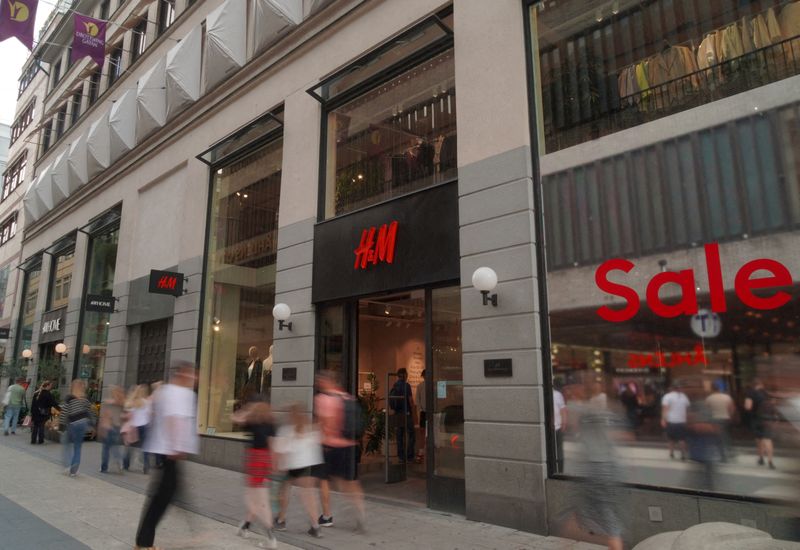
© Reuters. FILE PHOTO: Pedestrians and shoppers walk past a branch of fashion retailer H&M in central Stockholm, Sweden, July 17, 2023. REUTERS/Tom Little/File Photo
By Joice Alves
LONDON (Reuters) – European retailers have been unlikely stock market stars this year, but a long spell of high borrowing costs and inflation has started to bite, so wary investors will be looking for reassurances from the likes of H&M (ST:) and Zara-owner Inditex (BME:) when they issue business updates this week.
Last year, investors and strategists expected retailers’ margins to take a hit, as inflation eroded households’ discretionary spending and some of the region’s heavyweights warned of tough months ahead.
This gloomy forecast did not play out, with retailers largely able to pass costs on to consumers as demand proved more resilient than initially feared. The STOXX retailers index is up a whopping 25% to date – making it the best performing sector so far in 2023 after it was second-worst last year next to real estate.
The broader is up by 7% this year, meaning retailers are outperforming by the most on record.
The snag is that this stellar run has been partly built on investors unwinding bearish bets, or short positions, on retail stocks, after last year’s pessimism proved overdone. This means retail stocks might not see as many willing buyers as earlier this year.
“In 2022 short sellers had built positions in the sector and those have been unwound,” said Benjamin Jones, Director of Macro Research, Fundamental Multi Asset team at Invesco.
“We’d be more worried about fundamental weakness starting to show up more clearly in the coming months”.
Jones expects retail stocks to fall in the second half of the year. The index dropped in August and is down in September, but it is still just 5% below July’s 17-month highs.
And now, with inflation slowing down, the accumulated effects of costlier credit and months of surging prices are weakening demand.
Much of what happens next will depend on how the economy holds up, according to Florian Ielpo, Head of macroeconomics at Multi Asset Group Lombard Odier Asset Management.
“To see the sector’s further progress we need this late cycle context to continue and not become a recession: there, a soft-landing is of the essence,” he said, referring to central bank’s ability to bring inflation down without pushing the economy into recession.
“Risks to (economic) growth could make a switch out of cyclicals and toward more defensive stocks necessary,” Ielpo said.
Some retailers are considered cyclical because of how demand for their products tends to track economic swings, while defensive stocks, such as health care or utilities, tend to see more constant demand.
SHOPPING AROUND
With H&M, Inditex and home improvement specialist Kingfisher (LON:) issuing corporate updates in the next couple of weeks, investors will have a chance to judge how the sector is coping.
WH Smith shares sank last week after the British retailer reported its annual revenue jumped 28%, boosted by strong demand during a busy summer travel season, but the lack of upgrade to profit forecast disappointed investors.
Late last month, Alexandre Bompard, the chief executive of French supermarket Carrefour (EPA:) warned high prices were forcing people to slash spending and spoke of a “non-spending tsunami”.
While signs of inflation abating offer consumers some relief, retailers may struggle to preserve profit margins, analysts say.
JPMorgan downgraded the grocery retail sector this month and flagged the prospect of price declines going into 2024.
Last month, Deutsche Bank, while bullish on the general retail sector as it cited still robust consumer demand, sounded caution on home improvement and online retail businesses.
Retail valuations do not appear stretched compared to the broader market, with the STOXX retail index trading at 15.8 times forward earnings, compared to 12.3 for the STOXX 600, according to LSEG Datastream.
So far about half of Europe’s largest companies have reported second quarter results. Earnings in consumer non-cyclical companies, including grocers, fell 1.8% in the quarter, compared to 2.4% growth in the same period last year, data from LSEG I/B/E/S showed.
Consumer cyclical companies, such as apparel retailers, however, are showing resilience. They reported 13.5% in earnings growth in the second quarter, up from 10.6% last year, but there could be harder times ahead.
In Britain, a survey showed that most stores are expecting another tough month after retail sales fell in August at the fastest rate since March 2021. British consumer spending growth also lost pace last month.
In the 20 countries sharing the euro, retail sales fell for the 10th consecutive month in July, data showed last week, though the drop was smaller than expected as sales of food, drink and tobacco increased.







